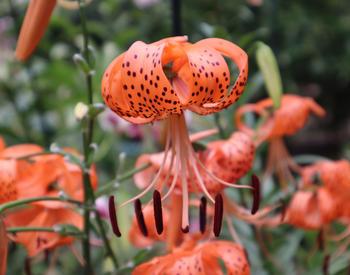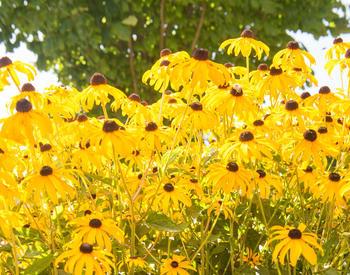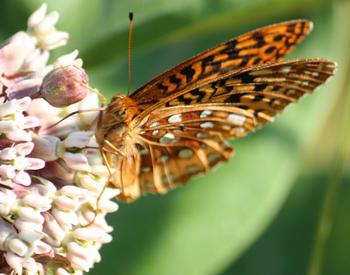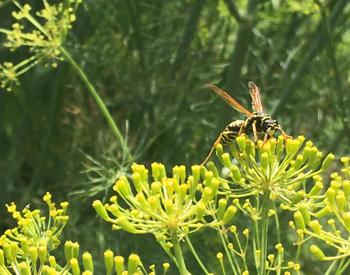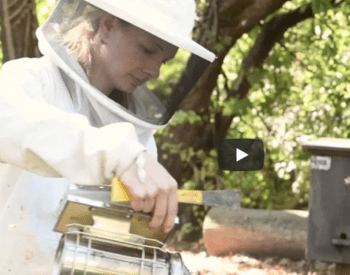CORVALLIS, Ore. – A honeybee hovers above hives and a native bumble bee visits a pink clover flower on a new themed Oregon license plate drawn by the youngest member of the Oregon State University Extension Service’s Master Melittologist program.
Marek Stanton, 16, started the drawing more than a year ago. A student at Summit Learning Charter in Eagle Rock, he worked with Andony Melathopoulos, OSU Extension pollinator health specialist, and Sarah Kincaid, faculty research assistant, on the inspiration behind the drawing. Melathopoulos and Kincaid gave him a rough idea, and then Stanton was given free rein to design it.
At least 3,000 plates must be pre-ordered before the plate is officially produced by the Driver and Motor Vechicle Services Division of Oregon Department of Transportation. That can be done by visiting the Pollinator Paradise website. The plates have a $40 specialty surcharge when initially ordered, along with the regular title, registration and plate fees.
For each sale, $35 goes to support bee research conducted by the OSU Extension Pollinator Health Lab and Honey Bee Lab programs. This revenue also has the potential to support graduate students doing bee research at OSU.
Kincaid and Melathopoulos said they should have no problem pre-selling 3,000 plates.
“I think it’s a big deal,” Kincaid said. “In a state like Oregon where so many people are passionate about bees, we should have a license plate celebrating that. With its abundance of native bees, Oregon should, too.”
The plate, which features a vivid pink clover field, green mountains and blue sky as a backdrop for the bees, symbolizes the relationship between bees and the state’s diverse agricultural industry, Kincaid said. Since native bumble bees are so drawn to clover and it is exported around the country for use as a cover crop, clover became the plate’s iconic representation of that relationship.
‘Born to create’
Marek said he started to draw as soon as he picked up a pencil. Over the years, his art blossomed. He dipped his hands in almost every medium – watercolor, acrylics, pastels, sculpture, blacksmithing, beadwork, embroidery and knitting.
“He was born to create,” said his mother, Kalika, with a mixture of wonder and pride. “He both learns and expresses himself through color and form. He was the kid covering the walls with crayons. At 3, he vandalized my white porcelain Christmas decorations because they ‘needed color.’ They are my favorite Christmas items now. They’re personalized.”
Marek is mostly self-taught. He has scoured the limited selection of books at the library and was excited to learn about the Master Melittologist program, which trains participants to become volunteers to identify native bees.
There was a problem, however. The minimum age is 18. So, Kalika signed up so Marek could participate. She’s come to every class and event with her son.
“We see Marek as representing the best of us,” Kincaid said. “He’s a bright young mind who’s passionate about this field and wants to share his knowledge and abilities with Oregonians.”
Melathopoulos noted that few amateur melittologists have Marek’s understanding of bee diversity and biology.
“He has a real feel for the bees of the state and knows how to translate this into an image that brings bees to life,” Melathopoulos said.
The idea for a bee-themed plate has been kicking around since Kincaid suggested it several years ago. But it seemed too big an undertaking to work through the Oregon Legislature for approval. Recently DMV changed its rules for applying for a special-themed plate and the idea cemented. As they cast about for an artist, Marek quickly came to mind.
“Marek has a great story,” Kincaid said. “He’s the first youth Master Melittologist. Along the way we learned he was an artist and we found out how remarkable he is and asked him to create something. And he’s also very gracious about his art. He made all the staff and instructors an original painting of a bee, all different.”
Marek’s love affair with natural history started about the same time he began art. He loved animals and started out watching birds, then became interested in insects. He briefly turned his attention to ants and soon became fascinated with bees.
Attends every class and event
The information collected by Master Melittologists is used for Oregon’s Bee Atlas, an ongoing list of Oregon’s 600 native bees that helps efforts to improve pollinator health.
To become a certified Master Melittologist, participants must complete five training modules and attend a one-day field day and do 20 hours of volunteer work. Marek has completed it all, attending every class and event, most of which were held online in 2020 because of the COVID-19 pandemic.
He watched all of the Bee Project’s The Wild World of Bees free webinars in 2020, including one at his grandmother’s house after his family evacuated their home as the wildfires knocked at their door.
“[Marek] would pop up in the chat during the World of Bees webinars with sophisticated remarks and we would send him additional information,” Kincaid said. “We thought he was 65. When we met him in person, we were shocked.”
Marek said, “It was during the 2020 webinars, that I connected with Andony. It was impressive how much time he spent answering my questions. I greatly appreciate the support and number of opportunities that Sarah, Andony and other members of the Oregon Bee Atlas have given me. I am truly lucky to have parents that are willing to dedicate this amount of time and energy.”
Marek, who is interested in majoring in biology with an emphasis on entomology in college, began the ambitious plan to document natural life around his home.
“It started out when I was around 10 trying to document all life in our garden with my mom and brother,” he said. “There are a huge number of species found in a well-cared-for garden. We found that out really quickly and looking back, I continue to realize how lofty that goal was.”

